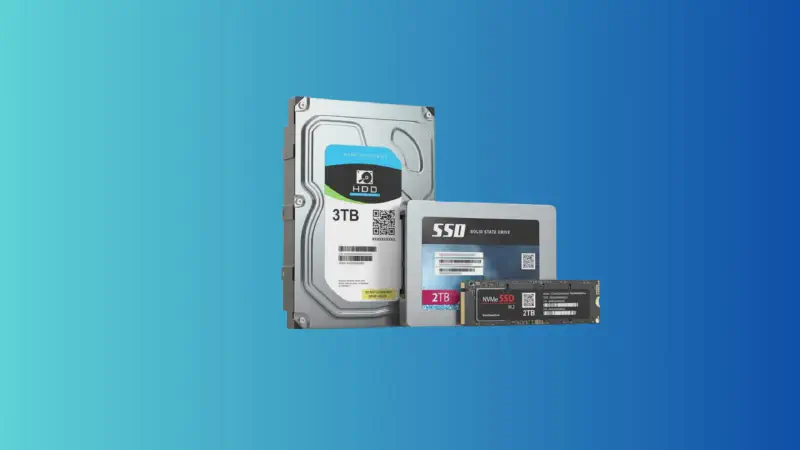# Fundamentals of Mass Storage Devices: Exploring HDDs and SSDs
# Introduction
In modern computers, we encounter two primary types of data storage devices: HDDs (Hard Disk Drives) and SSDs (Solid State Drives). Each has distinct advantages and disadvantages. HDDs typically offer larger storage capacities at a lower cost, whereas SSDs stand out for their superior speed but usually come with a higher price and lower storage capacity.
# How HDD Works?
HDDs function with mechanical parts, which gives them a unique set of characteristics.
# Key Components:
- Platters: The spinning disks that store data magnetically.
- Spindle: A motor-driven axis that spins the platters.
- Read/Write Heads: Located on actuator arms, these heads read and write data on the platters.
- Actuator Arm: Moves the read/write heads across the platters.
- Servo Motor: Controls the precise movement of the actuator arm.
# Operational Mechanics:
- Write Operation: During a write operation on an HDD, the disks rotate on the spindle. The arm with a read/write head moves, changing the polarity of cells on the magnetic disk, effectively switching the magnetic regions to represent binary states of 0 or 1. These sequences are stored in data tables within specifically allocated memory.
- Read Operation: For reading, the HDD uses the sequences of magnetic regions from the data table stored in allocated memory. Like the write process, the disks rotate, and the arm with read/write heads moves to read information from the magnetic disk.
- Data Transfer: Modern HDDs primarily use the SATA interface for data transfer, while older versions employed IDE or PATA.
# Pros and Cons of HDD:
Pros:
- Price: More cost-effective compared to SSDs.
- Storage Capacity: Typically offers larger disk space.
Cons:
- Speed: Slower than SSDs due to mechanical parts.
- Durability: Mechanical components can wear out over time.
# How SSD Works?
In contrast to HDDs, SSDs (Solid State Drives) use interconnected flash memory chips for data storage. This absence of moving parts gives SSDs several advantages.
# Key Components:
- Flash Memory Chips: These chips store data, similar to HDD’s spinning disks.
- Controller: Functions as the SSD’s brain, orchestrating data storage and communication.
# Operational Mechanics:
- Storing Data: The SSD’s controller writes data to the flash memory chips, organized in pages and blocks.
- Reading Data: For file access, the controller retrieves data directly from the memory chips, facilitating swift data access.
- Data Transfer: SSDs use interfaces like SATA or NVMe, impacting the speed of data transfers with the computer.
# Pros and Cons of SSDs:
Pros:
- Speed: SSDs provide rapid startup and swift file access, significantly enhancing computing efficiency.
- Durability: With no moving parts, SSDs are less susceptible to physical shock, reducing the risk of mechanical failure.
- Energy Efficiency: SSDs consume less power, contributing to longer battery life in laptops and quieter operation.
Cons:
- Cost: SSDs are generally more expensive per gigabyte compared to HDDs, making them a higher initial investment.
- Storage Capacity: While improving, the storage capacity of SSDs is typically lower than that of HDDs at similar price points.
- Longevity: The flash memory in SSDs has a limited number of write cycles, potentially leading to a shorter lifespan than HDDs under heavy use.
# Mass Storage Data Interfaces
# SATA (Serial ATA) Overview:
- Introduction: Launched in 2000 as an improvement over Parallel ATA.
- Limitations: Hindered by cable size, cost, and performance.
- HDD Compatibility: Effective for earlier HDDs but limited with modern SSDs.
- Performance: HDDs reach 50-120 MB/s, whereas SSDs using SATA can go up to 550 MB/s.
- System Improvement: Using SATA-based SSDs can improve system performance by 10-15 times over HDDs.
# NVMe (Non-Volatile Memory Express) Overview:
- Launch: Introduced in 2011 to surpass SATA limitations.
- Technology: Utilizes PCIe bus for higher bandwidth.
- Bandwidth Potential: PCIe 4.0 supports up to 64,000MB/s, far exceeding SATA III’s 600MB/s limit.
- Command Queues: Allows for 65535 queues, each with up to 65536 commands (compared to SATA’s single queue with 32 commands).
- Advantages: Improved efficiency, performance, and compatibility across systems.
- Industry Standard: Poised to become the new standard in storage technology.
# Storage Device Form Factors:
M.2:
- Design: Compact physical size (width 22mm; lengths 30, 42, 80, 110mm).
- Compatibility: Supports SATA and is the most common form factor for NVMe SSDs.
- Evolution: Likely to change as technology advances and miniaturizes.
mSATA (mini-SATA):
- Design: A smaller variant of the standard SATA SSD, designed for space-constrained environments.
- Compatibility: Exclusively supports the SATA interface. Unlike M.2, it does not accommodate PCIe connections.
- Application: Ideal for smaller form factor systems, such as ultra-portable laptops or compact desktops, where saving space is a priority.
U.2:
- Target Market: High-cost, high-performance devices mainly for data centers and enterprise storage.
- Characteristics: Superior performance and durability.
Add-in PCIe Cards:
- Usage: For systems without M.2 sockets.
- Performance: High-performing NVMe SSDs.
- Adoption: A transitional solution for integrating NVMe SSDs into existing systems.
# Conclusion
Understanding the mechanics of HDDs and SSDs is crucial in the computing world. HDDs offer cost-effectiveness and larger storage, while SSDs excel in speed, durability, and efficiency. The advancements in storage technologies, including SATA, NVMe, and various form factors like M.2, mSATA, U.2, and PCIe cards, highlight the rapid evolution in data storage technology.
